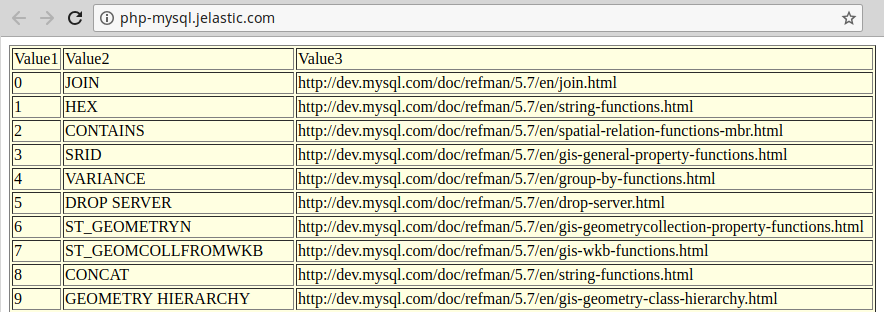Connection to MySQL/MariaDB/Percona for PHP
MySQL, MariaDB, and Percona are highly popular open source databases, used by developers all over the world. Follow the instruction below to learn how to connect your PHP application, hosted within the platform, to one of these DB servers:
Environment Creation
1. Log into your PaaS account and create an environment with MySQL or MariaDB database server (both are available within the SQL wizard section).

In order to provide a connection example, we’ve added Apache PHP application server.
2. After environment creation, you’ll get an email with the MySQL (or MariaDB) administration and connection details:

3. Return to your dashboard and click the Open in Browser button for the appropriate database node (either MySQL or MariaDB).

Log into the opened admin panel using credentials you’ve received in the above-mentioned email.
4. Go to the Databases tab and Create a new database (e.g., mysqldb).

Now, you can deploy your application (either from archive or GIT/SVN repository) to the created environment.
Connection to Database
Once your project is successfully deployed, you need to connect it to your database. For that, your application should be appropriately configured, for example using the inbuilt MySQLi (MySQL Improved) extension.
Refer to the linked official documentation page for the full list of available functions, while we’ll overview just the basic ones below:
1. To get a connection string for accessing your MySQL/MariaDB node:
| |
The appropriate placeholders should be substituted with your connection data from the MySQL or MariaDB node:
- {host} - link to your DB node without protocol part
- {user} and {password} - database admin credentials (for production usage, it’s recommended to create a dedicated account with the appropriate permissions)
- {db_name} - name of required database (e.g. the previously created mysqldb one)
2. For switching to different database within the same server, use the next function:
| |
Here, the {connect} should be substituted with the connection string obtained using the above-described mysqli_connect function.
3. In order to close a connection to your database, execute the following:
| |
Checking Connection
In order to ensure everything works fine, you can check the connection using this code:
| |
If everything is OK, you’ll get the following message, when this page is opened in browser.

Executing Simple Request
And here is an example on how to execute a simple request to your database and output it onto a table.
The plain PHP script below will establish a connection to your database server (do not forget to specify the appropriate hostname and credentials), connect to the default mysql database it contains, read the values from the help_topic table and display them in a self-generated table.
| |
As a result, you’ll receive a kind of index for all available MySQL functions with links to the instructions on their using.

Great! Now you can easily connect your PHP application to the MySQL or MariaDB database.
Useful to Know
The platform also lets you extend your MySQL/MariaDB servers functionality by following the appropriate instructions in our documentation:
- set up the preferred database replication type - primary-secondary or primary-primary - in order to get the increased DB performance and data loss protection
- adjust Backups Scheduling for ensuring safety of the information inside your DBs in the case of unexpected server failure
- see the Remote Access instruction and learn how to access your database remotely via the preferred desktop MySQL client
- use the Dump Files Import/Export guide to find out how to manually backup and restore your data from the previously created dumps